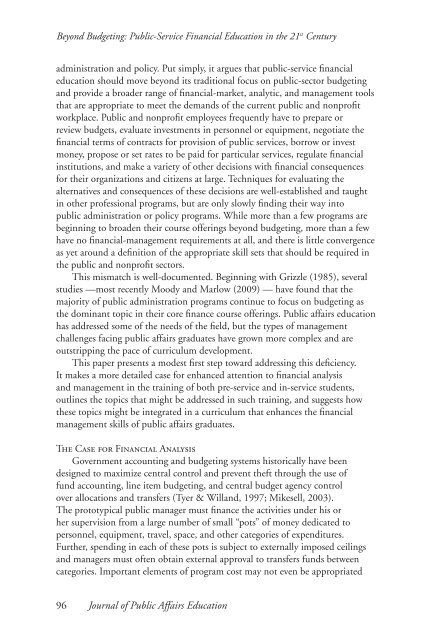Beyond Budgeting: Public-Service Financial Education in the 21st ...
Beyond Budgeting: Public-Service Financial Education in the 21st ...
Beyond Budgeting: Public-Service Financial Education in the 21st ...
You also want an ePaper? Increase the reach of your titles
YUMPU automatically turns print PDFs into web optimized ePapers that Google loves.
<strong>Beyond</strong> <strong>Budget<strong>in</strong>g</strong>: <strong>Public</strong>-<strong>Service</strong> <strong>F<strong>in</strong>ancial</strong> <strong>Education</strong> <strong>in</strong> <strong>the</strong> 21 st Century<br />
adm<strong>in</strong>istration and policy. Put simply, it argues that public-service f<strong>in</strong>ancial<br />
education should move beyond its traditional focus on public-sector budget<strong>in</strong>g<br />
and provide a broader range of f<strong>in</strong>ancial-market, analytic, and management tools<br />
that are appropriate to meet <strong>the</strong> demands of <strong>the</strong> current public and nonprofit<br />
workplace. <strong>Public</strong> and nonprofit employees frequently have to prepare or<br />
review budgets, evaluate <strong>in</strong>vestments <strong>in</strong> personnel or equipment, negotiate <strong>the</strong><br />
f<strong>in</strong>ancial terms of contracts for provision of public services, borrow or <strong>in</strong>vest<br />
money, propose or set rates to be paid for particular services, regulate f<strong>in</strong>ancial<br />
<strong>in</strong>stitutions, and make a variety of o<strong>the</strong>r decisions with f<strong>in</strong>ancial consequences<br />
for <strong>the</strong>ir organizations and citizens at large. Techniques for evaluat<strong>in</strong>g <strong>the</strong><br />
alternatives and consequences of <strong>the</strong>se decisions are well-established and taught<br />
<strong>in</strong> o<strong>the</strong>r professional programs, but are only slowly f<strong>in</strong>d<strong>in</strong>g <strong>the</strong>ir way <strong>in</strong>to<br />
public adm<strong>in</strong>istration or policy programs. While more than a few programs are<br />
beg<strong>in</strong>n<strong>in</strong>g to broaden <strong>the</strong>ir course offer<strong>in</strong>gs beyond budget<strong>in</strong>g, more than a few<br />
have no f<strong>in</strong>ancial-management requirements at all, and <strong>the</strong>re is little convergence<br />
as yet around a def<strong>in</strong>ition of <strong>the</strong> appropriate skill sets that should be required <strong>in</strong><br />
<strong>the</strong> public and nonprofit sectors.<br />
This mismatch is well-documented. Beg<strong>in</strong>n<strong>in</strong>g with Grizzle (1985), several<br />
studies —most recently Moody and Marlow (2009) — have found that <strong>the</strong><br />
majority of public adm<strong>in</strong>istration programs cont<strong>in</strong>ue to focus on budget<strong>in</strong>g as<br />
<strong>the</strong> dom<strong>in</strong>ant topic <strong>in</strong> <strong>the</strong>ir core f<strong>in</strong>ance course offer<strong>in</strong>gs. <strong>Public</strong> affairs education<br />
has addressed some of <strong>the</strong> needs of <strong>the</strong> field, but <strong>the</strong> types of management<br />
challenges fac<strong>in</strong>g public affairs graduates have grown more complex and are<br />
outstripp<strong>in</strong>g <strong>the</strong> pace of curriculum development.<br />
This paper presents a modest first step toward address<strong>in</strong>g this deficiency.<br />
It makes a more detailed case for enhanced attention to f<strong>in</strong>ancial analysis<br />
and management <strong>in</strong> <strong>the</strong> tra<strong>in</strong><strong>in</strong>g of both pre-service and <strong>in</strong>-service students,<br />
outl<strong>in</strong>es <strong>the</strong> topics that might be addressed <strong>in</strong> such tra<strong>in</strong><strong>in</strong>g, and suggests how<br />
<strong>the</strong>se topics might be <strong>in</strong>tegrated <strong>in</strong> a curriculum that enhances <strong>the</strong> f<strong>in</strong>ancial<br />
management skills of public affairs graduates.<br />
The Case for <strong>F<strong>in</strong>ancial</strong> Analysis<br />
Government account<strong>in</strong>g and budget<strong>in</strong>g systems historically have been<br />
designed to maximize central control and prevent <strong>the</strong>ft through <strong>the</strong> use of<br />
fund account<strong>in</strong>g, l<strong>in</strong>e item budget<strong>in</strong>g, and central budget agency control<br />
over allocations and transfers (Tyer & Willand, 1997; Mikesell, 2003).<br />
The prototypical public manager must f<strong>in</strong>ance <strong>the</strong> activities under his or<br />
her supervision from a large number of small “pots” of money dedicated to<br />
personnel, equipment, travel, space, and o<strong>the</strong>r categories of expenditures.<br />
Fur<strong>the</strong>r, spend<strong>in</strong>g <strong>in</strong> each of <strong>the</strong>se pots is subject to externally imposed ceil<strong>in</strong>gs<br />
and managers must often obta<strong>in</strong> external approval to transfers funds between<br />
categories. Important elements of program cost may not even be appropriated<br />
96 Journal of <strong>Public</strong> Affairs <strong>Education</strong>
















